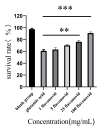Effects of Extraction Technique on the Content and Antioxidant Activity of Flavonoids from Gossypium Hirsutum linn. Flowers
- PMID: 36080389
- PMCID: PMC9458133
- DOI: 10.3390/molecules27175627
Effects of Extraction Technique on the Content and Antioxidant Activity of Flavonoids from Gossypium Hirsutum linn. Flowers
Abstract
Cotton is one of the Uyghur medical materials in China and is rich in flavonoids. Flavonoids have important pharmacological effects. The yield of flavonoids in traditional extraction methods is low, which affects the development of flavonoids. Therefore, it is urgent to optimize the extraction techniques. The yield of flavonoids in cotton flowers was effectively improved by response surface methodology, and the highest yield of flavonoids reached 5.66%, and the optimal extraction process conditions were obtained. The DPPH free radical scavenging rate, hydroxyl free radical scavenging rate, superoxide anion free radical scavenging rate, and reducing ability were tested to reflect the antioxidant capacity of flavonoids. The flavonoids had an excellent antioxidant effect. Cell experiments suggested that the flavonoids had the effect of protecting glutamate-induced damage to HT-22 cells. The results of this study provide a theoretical basis for the extraction of cotton flowers flavonoids and the comprehensive evaluation of antioxidant products, as well as the extraction of other plant flavonoids.
Keywords: antioxidant activity; cotton flowers flavonoids; extraction process; response surface methodology.
Conflict of interest statement
The authors declare that they have no conflict of interest.
Figures




References
-
- Mirzaei R., Yunesian M., Nasseri S., Gholami M., Alilzadeh E., Shoeibi S., Bidshahi H.S., Mesdaghinia A. An optimized SPE-LC-MS/MS method for antibiotics residue analysis in ground, surface and treated water samples by response surface methodology—Central composite design. J. Environ. Health Sci. Eng. 2017;15:21. doi: 10.1186/s40201-017-0282-2. - DOI - PMC - PubMed
MeSH terms
Substances
Grants and funding
- SKLTOF20210101/The Open Fund of State Key Laboratory of Tea Plant Biology and Utilization
- RZ2000001209/Anhui Provincial Department of Education 2020 Key Project of Natural Science in Colleges and Universities
- gxgwfx2019027/Anhui Province Colleges and Universities Outstanding Talents Cultivation Overseas Visiting Program
- 1808085MC71/the Natural Science Foundation of Anhui Province
LinkOut - more resources
Full Text Sources
Medical

